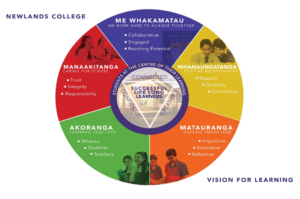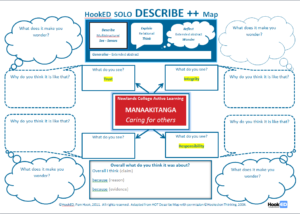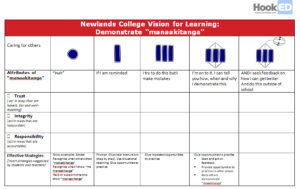A question from Siobhan in New Zealand
We met when you came to [xxxxxx College] last term. In between one of the slots with the teachers, I was asking you about ways to link SOLO to our school values. You said you may have some ideas that you could share with me. Please if you could that would be much appreciated. I also made a note on a bit of paper to ask you about ” 2 slices of bread” ??? Hope that makes sense!!! Siobhan – Secondary teacher New Zealand
An answer
Part 1: Using SOLO Taxonomy in a collaborative exploration of school values – espoused and enacted.
Identify what matters in your school – your school vision for learning. For example – Successful lifelong learners
 Step 1: Use SOLO hexagons to brainstorm the beliefs and or ideals that you think will matter most in building this vision in your learning community. What would it look like or feel like to demonstrate or experience these values? Work in groups to look for connections between your hexagons and the hexagon ideas of others. Annotate the connections with reasons. Next, step back from the tessellated hexagons and draw a conclusion/s about the clusters of values that stand out – these will become the essential values for your community of learners.
Step 1: Use SOLO hexagons to brainstorm the beliefs and or ideals that you think will matter most in building this vision in your learning community. What would it look like or feel like to demonstrate or experience these values? Work in groups to look for connections between your hexagons and the hexagon ideas of others. Annotate the connections with reasons. Next, step back from the tessellated hexagons and draw a conclusion/s about the clusters of values that stand out – these will become the essential values for your community of learners.
Note – the different values will interact and reinforce each other and your school vision.
Step 2: Work in groups using the HookED SOLO Describe ++ Map to describe the characteristics or attributes of each school value – make inferences (why do you think it is like that?) about each attribute and then wonder (ask questions). What you would see if this value/these values were both espoused and enacted across the school campus?

You can self-assess the depth of your declarative knowledge using a SOLO Describe++ visual rubric or use the HookED SOLO Declarative knowledge rubric generator to make one of your own.
Step 3: Use the thinking from Step 2 to co-create a functioning knowledge rubric for how staff/students might demonstrate the value (e.g. respect) at school and in their lives. Come up with effective strategies for staff and students to increase the SOLO level of their functioning knowledge outcome for an identified value.

You can create a text based rubric using the HookED SOLO Functioning knowledge rubric generator or a visual comic strip rubric using a program like ComicLife
Examples from the Active Learning Initiative at Newland’s College, Wellington New Zealand
Part 2: The boy with the bread sandwich
Two slices of bread is a great memory prompt. It refers to an article in the New Yorker Magazine that helped me better understand resilience. To understand how labeling an experience as traumatic might make it so. The bread sandwich narrative reminds us that we can be blind to alternative explanations and solutions when we make generalisations about what happens in school. In attempting to address inequity we must never neglect the importance of “positive deviance” in educational thinking.
The boy with the bread sandwich was part of a special group of children. He belonged to a cohort of kids—the first of many—whom Garmezy would go on to identify as succeeding, even excelling, despite incredibly difficult circumstances. These were the children who exhibited a trait Garmezy would later identify as “resilience.” (He is widely credited with being the first to study the concept in an experimental setting.) Over many years, Garmezy would visit schools across the country, focussing on those in economically depressed areas, and follow a standard protocol. He would set up meetings with the principal, along with a school social worker or nurse, and pose the same question: Were there any children whose backgrounds had initially raised red flags—kids who seemed likely to become problem kids—who had instead become, surprisingly, a source of pride? “What I was saying was, ‘Can you identify stressed children who are making it here in your school?’ “ Garmezy said, in a 1999 interview. “There would be a long pause after my inquiry before the answer came. If I had said, ‘Do you have kids in this school who seem to be troubled?,’ there wouldn’t have been a moment’s delay. But to be asked about children who were adaptive and good citizens in the school and making it even though they had come out of very disturbed backgrounds—that was a new sort of inquiry. That’s the way we began.” Maria Konnikova The Secret Formula For Resilience.




